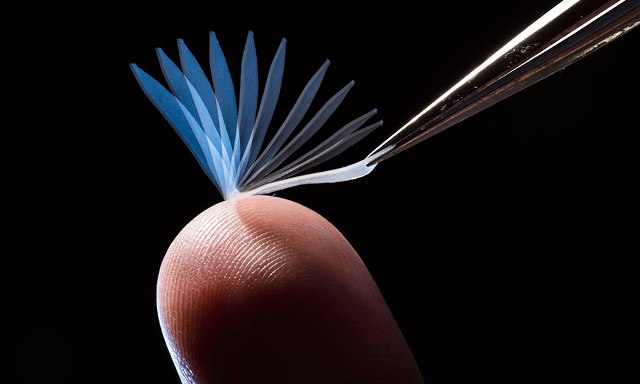Feb 11 2016
When exposed to changes in temperature the shape of polymers often visibly change. New research, led by chemical engineering professor Mitch Anthamatten at the University of Rochester, has led to the development of a material capable of changing shape when exposed to body heat alone. This research paves the way for unique medical and other applications.
 A time-lapse photo of a new shape-memory polymer reverting to its original shape after being exposed to body temperature. (University of Rochester photo / J. Adam Fenster)
A time-lapse photo of a new shape-memory polymer reverting to its original shape after being exposed to body temperature. (University of Rochester photo / J. Adam Fenster)
Anthamatten worked with graduate student Yuan Meng to create this material, which is a type of shape-memory polymer. Shape-memory polymers are materials that can be programmed to retain a temporary shape until triggered to return to its original shape. The trigger in this case is heat.
Tuning the trigger temperature is only one part of the story. We also engineered these materials to store large amount of elastic energy, enabling them to perform more mechanical work during their shape recovery.
Professor Mitch Anthamatten, Chemical Engineering, University of Rochester
Shape Memory Polymers: Plastic with a Brain, and Some Muscle
Shape Memory Polymers: An Elastic Like You've Never Seen
Mitch Anthamatten Explains a Shape-Memory Cycle Involving Strain Induced Crystallization
Mitch Anthamatten Explains a Shape-Memory Cycle Involving Strain Induced Crystallization
Discovering a method to control crystallization when the material is stretched or cooled enabled the development of the new polymer. Polymer chains are locally stretched when the material deforms. This causes small segments of the polymer to line up in the same direction in small areas called crystallites, which transforms the material into a deformed shape temporarily. This temporary shape is maintained as the number of crystallites increases, making it difficult for the material to regain its original shape. By adding molecular linkers to connect the individual polymer strands, the team were able to manage the trigger temperature.
Anthamatten and team observed that when the material is stretched, these linkers restrained crystallization but did not stop it completely. The researchers managed to alter the stability of the material and precisely fix the melting point at which the shape change is triggered, by changing the types and number of linkers applied, and the manner in which they are spread throughout the polymer network.
When the new polymer was heated to about 35°C, which is below the temperature of the body, the crystallites began to separate and the polymer regained its original shape.
Our shape-memory polymer is like a rubber band that can lock itself into a new shape when stretched, but a simple touch causes it to recoil back to its original shape.
Professor Mitch Anthamatten, Chemical Engineering, University of Rochester
The team’s objective was to develop a polymer with precisely controlled trigger temperature, and enable that material to deliver a large amount of mechanical work while recovering its original shape. As a result, they were able to improve their polymer networks to store the maximum amount of elastic energy possible.
Nearly all applications of shape memory polymers will require that the material pushes or pulls on its surroundings. However, researchers seldom measure the amount of mechanical work that shape-memory polymers are actually performing.
Professor Mitch Anthamatten, Chemical Engineering, University of Rochester
The shape-memory polymer possesses the ability to lift an object weighing one-thousand times its weight. A shoelace-sized polymer weighing about a gram would be able to lift one liter soda can.
Anthamatten believes that the newly developed shape-memory polymer can be utilized in a number of applications, such as body-heat assisted medical dispensers, artificial skin, sutures, and self-fitting apparel.
The findings of this study are published in the Journal of Polymer Science Part B: Polymer Physics.